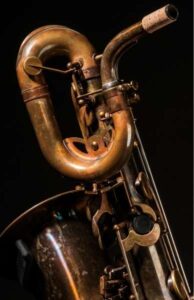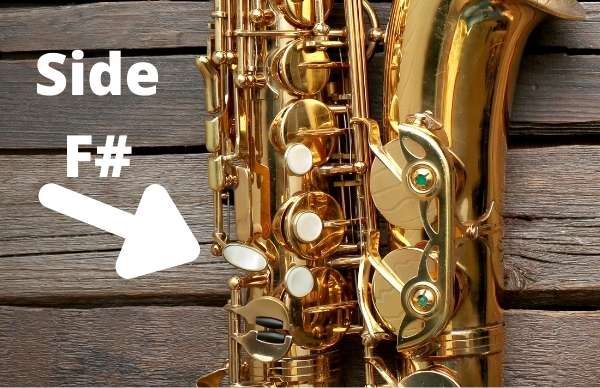Many people know that saxophones come in many different sizes with the most common being the tenor and alto. But not many people know the extended family members of the saxophone section or the similarities of them. One of the biggest questions new saxophone players have is do all saxophones have the same keys?
In general, all saxophones will have the same keys that function the same way. There are a few exceptions, notably, baritone saxes have a low A key under the thumb pad of the left hand and some soprano saxes have a high G key next to the octave key.

While the keys may be further apart, the same ones exist on all saxophones and are in the same layout. For instance, the left-hand stack of keys will always have a bis key (small key under the B,) the same array of spatula keys (operated by the left pinky; G#, Low B, Bb, and C#,) and palm keys (High D, Eb, and F.)
Why Don’t Alto Or Tenor Saxophones Have A ‘Low A’ Key?
Generally, alto and tenor saxes don’t have a low A key mostly for practicality. Since a baritone sax represents the “bass” of the sax section, it makes sense for it to have an extended range. It also has adequate bell size, which makes it easier to adjust where the low A key sits when building the instrument.
Baritone saxes sit at the bass end of the saxophone section, so having a concert low C (that’s the actual pitch of a baritone low A) makes sense.
Alto and tenor saxes have a lot of overlap in their pitches and tonality (though, to be fair so do tenors and baritones) but nothing in a typical sax section will overlap with the low end of a baritone.
Saxes With a Low ‘A Key’

As mentioned above, most baritone saxes (exceptions are usually student models) will have a low A key but, weirdly enough, bass and contrabass saxophones won’t have one.
The low A key is a bari sax “signature key” since it’s such a common thing on bari’s, but almost non-existent on other saxophones.
I say “almost” because there have been a few exceptions to other saxes having a low A key, namely the Selmer Mark VI Low A.
Unfortunately, this sax was developed in the 1960s and, while you can find them on eBay or similar sites, they cost a pretty penny.
I’m sure there are other exceptions out there and you can probably find some obscure brand of alto or tenor sax with a low A, but they are rare.
Why Don’t All Saxophones Have A High G Key?
Having to cut an extra tone hole for a high G key would likely interfere with the neck tenon. It would also add cost and potential and mechanical issues. A high G key also wouldn’t be practical since alto and tenor saxophones have an extended technique called altissimo to achieve higher notes.
But likely the main reason all saxophones don’t have a high G key is due to practicality. Young saxophonists have no need for it since they aren’t playing that high and college-level/professionals are going to be utilizing a fingering technique called altissimo to achieve high notes.
When alto or tenor saxophones are playing that high it’s usually to add emphasis to what they are playing and they don’t usually stay up in that range for very long…I mean, the sax is a versatile instrument so players move all over the horn.
Even though it’s debated, the high G is more fitting for soprano sax because it is the usual upper voice of a sax quartet and there isn’t a higher instrument that it will have overlap with. Unlike the alto, for instance, which has upper notes that share pitch with the lower end of the soprano…though, to be fair, the timbre (character of the sound, i.e. full, nasal, bright, dark, etc.) is different.
Saxes With A High G Key
While not as “standard” as a baritone sax with a low A key, many soprano saxes are now coming with a high G key notably on some Yamaha and Yanagisawa models. You can spot a high G key by looking next to the octave key, if there is a smaller key sitting next to it, bingo!
There is some debate on saxophone forums and music schools about whether a high G key is needed. Some argue that the extra key is nice to have to save on having to figure out the altissimo fingerings.
But it seems like the majority of folk think the added key just extends an already shrill range and just adds unnecessary cost and potential mechanical issues.
What Other Key Mechanics Are Different Between Saxophones?
Sopranos with a high G and Baritones with a Low A are by far the most notable differences, but there are a few others…usually associated with older horns or very inexpensive student models.
High F# Key
There are some alto and tenor saxes that don’t come with a high F# key. These are typically found on older, student models and professionals or college level students would have to rely on altissimo fingerings to high anything above a high F.
The lack of a high F# key is largely a thing of the past now, as most quality brand saxophones…even student models…will have this key.
Low Bb Key
Rare than lacking a high F# key, some…quite old…models of saxophone didn’t have a low Bb key. I believe this is one of the earlier changes to the horn since I can’t find any modern model (say 1980 to today) that lacked one.
It was likely due to the more complicated mechanics needed to operate the key so far down the bell of the horn.
Side F# Key
Some older saxophones, like the Martin baritone, don’t have a side F# key. This key is located on the side of the saxophone and operated by the middle or ring finger of the right hand.
It is mainly used as an alternative F# fingering or as an F to F# (Gb) trill key. Using the standard F# fingering is still the preferred method, but having a side F# allows for a smoother transition up some scales…mainly scales that require going from F natural to Gb (the enharmonic of F#.)

Final Thoughts
It’s pretty interesting to discover the subtle differences in key mechanisms between saxophones. Some, like the low A on baritone sax, are almost considered standard at this point while others, like the high G on a soprano, are considered nice to have but not missed if it isn’t there.
From a performance standpoint, the benefit of all saxophones having the same key mechanisms means that the fingerings across the board are the same, making it much easier to switch from sax to sax.
Your finger muscle memory doesn’t have to adjust too much (maybe just from the weight of the keys on bigger horns) and you only have to worry about changes to your embouchure (how you hold your mouth when you play.)
It’s also worth mentioning that a lot of older models had differently shaped keys, the aesthetic differences didn’t really change the function of the key but did sometimes make them more difficult to play, but also gives the instrument character!

